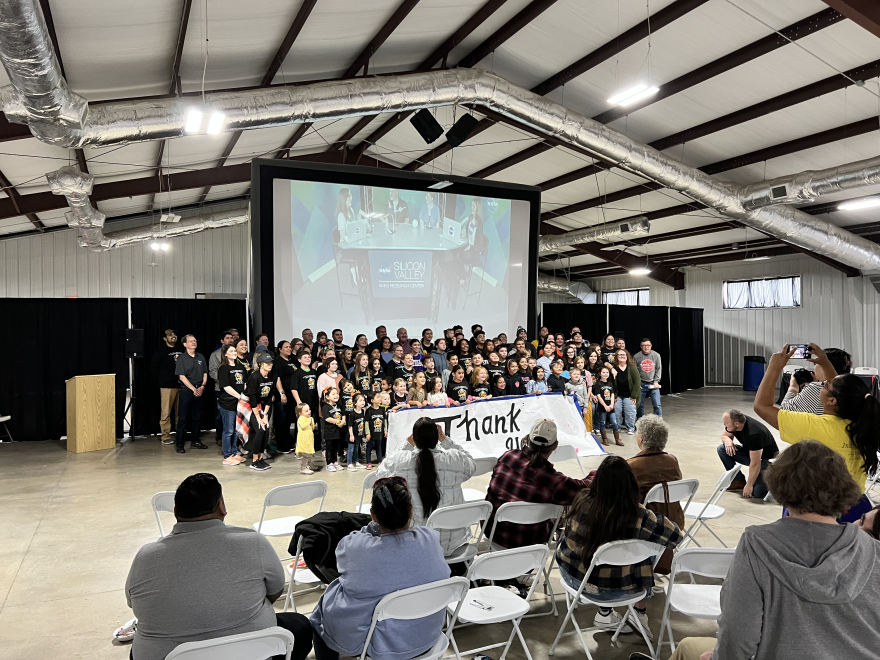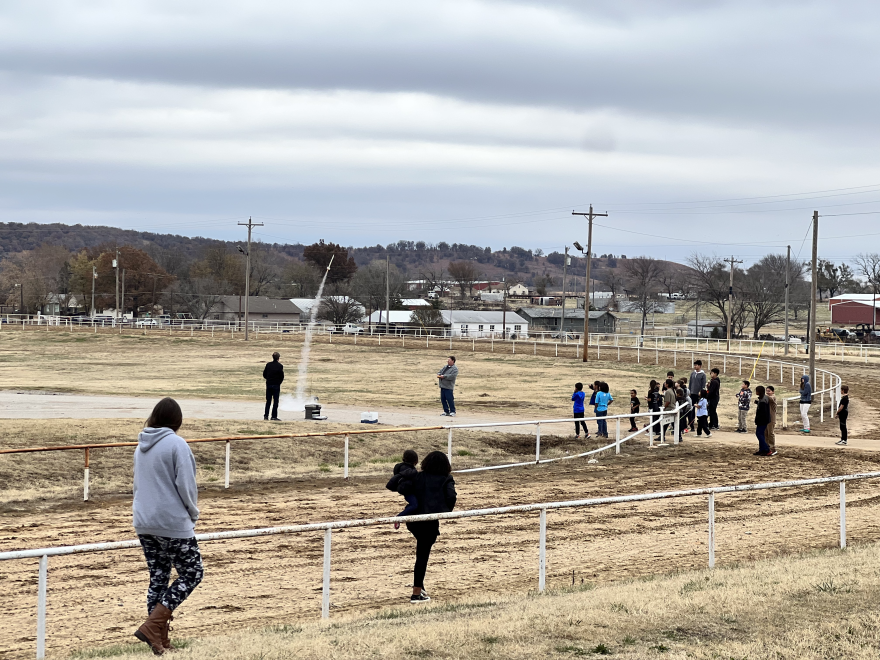NASA astronaut Nicole Mann spoke live from the International Space Station to Osage County students as she answered their questions about space.
The Osage name for the event was 𐓻𐓣͘𐓤𐓘𐓻𐓣͘ 𐓘𐓬𐓘 𐓨𐓣͘𐓥𐓘𐓤’𐓟 𐓪𐓥𐓣͘𐓟 𐓘𐓬𐓙, which translates to "the children are talking to the stars."
Nicole Anapu Mann became the first Indigenous American woman in space when she joined the crew of the International Space Station (ISS) in October. Mann is a registered member of the Wailacki of the Round Valley Indian Tribes in California.
Patrick Martin is the superintendent of 𐓈𐒰𐓄𐓂𐓆𐒼𐒰 𐒰⌃𐒼𐓂𐓈𐒰𐓬𐒻 (Daposka Ahnkodapi Elementary), the Osage Nation’s private elementary school. He said the school started the long application process to participate in a NASA Q&A last year.
“Our Chief Standing Bear, he was the visionary that started this ball rolling,” Martin said. “He wanted to watch 𐓏𐒰𐓓𐒰𐓓𐒷 𐒻𐒷, the Osage language, be spoken in space, and to have our children be part of that.”
Space heard its first Osage words in October when two students from the tribe’s private elementary school got to ask questions as part of an event with Indigenous news outlets from across the U.S.
“It's a big deal either way,” said Braxton Redeagle, the director of the Osage Nation Language Department. “They spoke the name the Osage Nation immersion school, Daposka Ahnkodapi, which means ‘our school.’”

At October’s event, Associated Press reporter Marcia Dunn relayed the questions, and the Daposka Ahnkodapi students’ questions were just two of many from around the country. Last week’s questions all came directly from Osage County students, who asked them via pre-recorded videos.
Over 100 attendees spent the morning doing space-themed activities in a building decorated with orange and blue balloons, the colors of the NASA crew’s flight suits. The crowd gathered around a projection screen to see Mann answer 20 questions from Osage County students.
“Watching Nicole Mann, float down on that screen was so amazing,” said Mary Wildcat, the director of the Osage Nation Education Department. “To be able to see and interact with the first Native American woman to go into space was just indescribable.”
Malana McGlaston, a fourth-grade student at Daposka Ahnkodapi, asked the first question. “Did you bring anything from your tribal heritage on this mission?” she asked.
Mann said she brought a dreamcatcher her mother gave her to the space station.
“I have it floating next to my crew quarters to remind me of home and keep my dreams good at night,” Mann said.
Mann also answered questions about how many languages are spoken by the ISS crew, how they divvy up chores, and whether you can grow tomatoes in space. Most came from students at Daposka Ahnkodapi, but students from Hominy and Pawhuska Public Schools also sent questions to the ISS.
Dominic Shackelford is a fifth-grader at Daposka Ahnkodapi. His question about what would happen if you shot a gun in space was addressed in Mann’s October Q&A session.
Mann explained that she didn’t know because it was too dangerous to shoot a gun on the space station.
Weeks later, Shackelford said he still wonders. “Would it bounce like a ping pong ball?” he said. “Would it just stop? Would it explode because of all the firepower?”

Shackelford and his classmates have been doing space-themed activities to prepare for their conversation with Mann.
“Last year, we made some experiments of shooting rockets,” Shackelford said. “It went great, actually—they went so high. A small engine can have a lot of power.”
Last week’s event featured even more cosmic fun. The Q&A took place at the Osage County Fairgrounds, and Attendees could design their own mission patch, like the SpaceX Crew-5 patch Mann wears. Students decorated space cookies, watched rocket demos from Tulsa Rocketry and toured the ISS using virtual reality headsets.
“The learning curve for us—with space, with NASA, with gravity—has just been exponential,” Superintendent Martin said. “We started at zero, and we’ve just been going up and up and up until today.”
Martin said one of their final activities before the Q&A event was a bonfire night where students, teachers and parents watched the ISS pass overhead.
“We were all out there, way out in the country, brilliant night sky,” Martin said. “We saw the astronauts fly by for three minutes. And it was so exciting for the kids. They just were awestruck, looking up into the sky and seeing the astronauts that we're going to talk to today.”
Robyn Rulo is an academic advisor with the Osage Nation Education Department. She said the students also learned Osage words that had to do with space.
Rulo said she hopes the event helped Osage students envision themselves in careers as astronauts, researchers or engineers.
It seems that mission has been a success. Fifth-grader Joseph Duty asked how Mann could tell when she reached microgravity. Duty said he needed to know because he might be interested in going to space himself someday.
“The more times we've exposed a lot of our students to these career paths, we show them the sky is the limit,” Rulo said. “By seeing Nicole Mann up in space, they're able to identify our people in space. And now it's possible to reach for the stars.”
This report was produced by the Oklahoma Public Media Exchange, a collaboration of public media organizations. Help support collaborative journalism by donating at the link at the top of this webpage.





